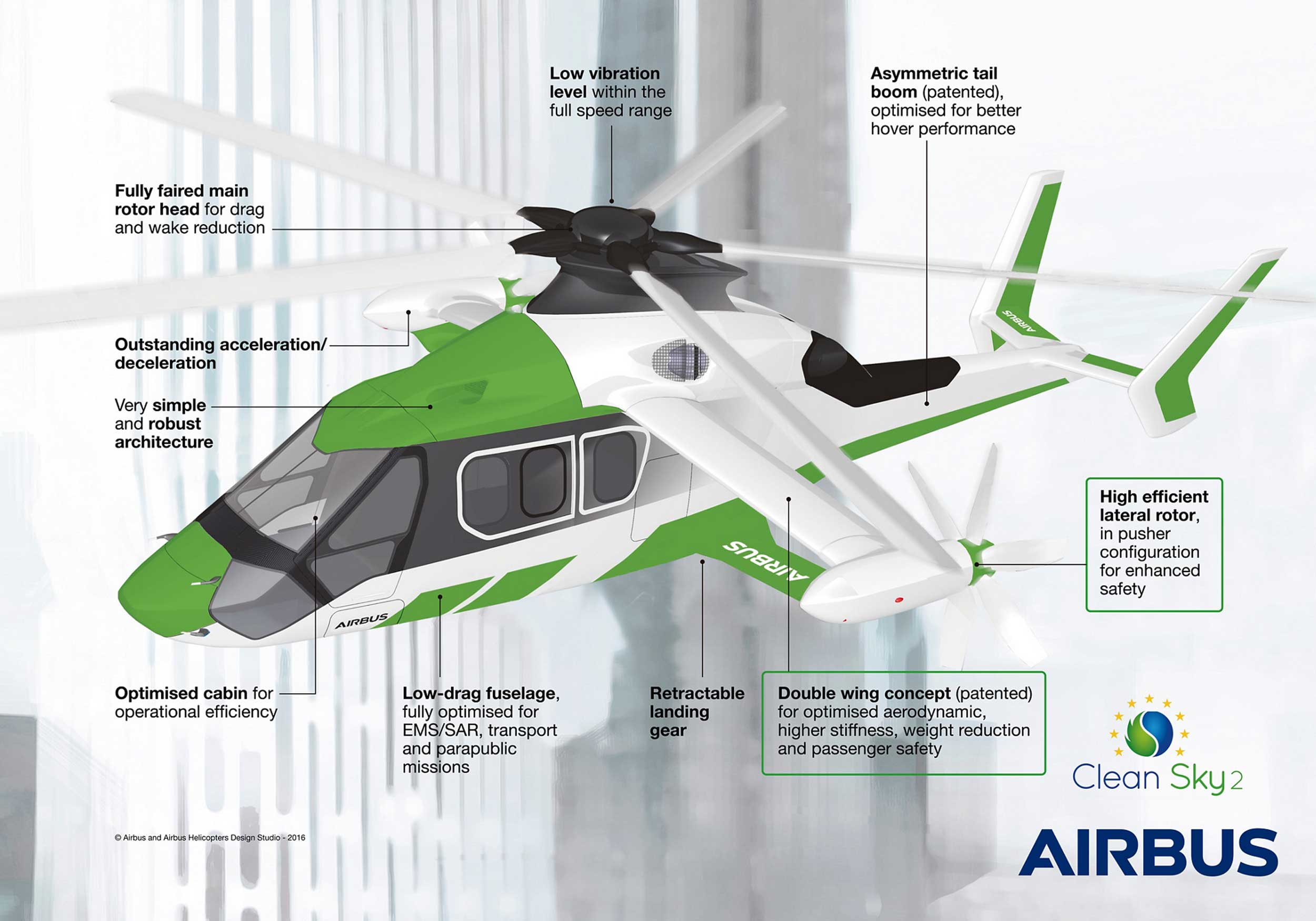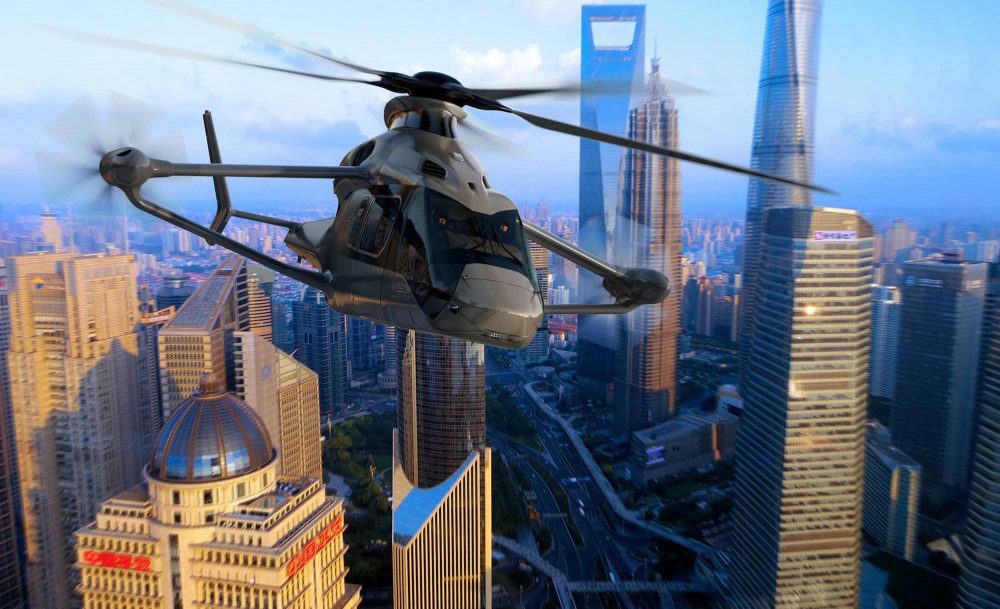Airbus Helicopters has releases details of its Racer high-speed demonstrator project including its proposed cruise speed of more than 216kt – typical high-speed cruise speed of a helicopter is around 140kt.
Somehow, Airbus has managed to convince the EU that the Racer is eligible
for European Research Clean Sky 2 project, which involves 40 partners in 13 European countries – and funding.
How does going faster become greener?
“The high-speed demonstrator aims to achieve the best trade-off between speed, cost-efficiency and mission performance,” says Airbus.
“Fuel savings will be generated thanks to the innovative Safran eco-mode hybrid-electrical system, which allows one of the two Aneto-1X engines to be shut down while in cruise flight. The particular architecture of the Racer formula will also contribute to lowering its operational acoustic footprint.”
The Racer was unveiled at the Paris Air Show in 2017, with manufacturing starting in 2020. “The recent completion of the demonstrator’s centre fuselage is a decisive milestone for the programme as it marks the start of the Racer’s assembly,” continues Airbus.
Assembly is starting at Airbus Helicopters’ site in Donauwörth, Germany and will involve the installation of several major components such as the canopy, the box-wings, the fuel system, the cowlings, and more.
Later this year, the Racer will be transferred to Airbus Helicopters’ site in Marignane, France for the final assembly and subsequent launch of the flight campaign in 2022.

Key features:
Central fuselage: Designed and manufactured by Romania’s RoRCraft consortium, the Racer’s lightweight airframe has both metallic and composite primary structural parts.
The side shells: Made of carbon fibre reinforced plastic (CFRP), the 3.4 x 1.5 metre cover for the Racer’s side panels connects the tail boom to the aircraft’s cockpit.
Such large format CFRP shells are traditionally made manually, but the Racer’s shell components have been manufactured in a highly automated process using a new method developed by a research team from the Fraunhofer Institute for Foundry, Composite and Processing Technology IGCV in Germany.
The canopy: Developed by the German FastCan consortium, formed by KLK Motorsport GMBH and Modell und Formenbau Blasius Gerg GmbH, the Racer’s innovative carbon fibre canopy is an example of the synergies between the automotive and aerospace industries.
The FastCan consortium has used automotive design expertise and manufacturing technologies to create a lightweight canopy, optimised for low aerodynamic draft and a good field of view.
The Racer canopy will integrate lightweight, erosion-resistant windows and windshields capable of withstanding bird strikes, even at high speeds, and were developed by the WIMPER consortium, which comprises the KRD Sicherheitstechnik GmbH, the German Aerospace Center DLR, the Institute of Structures and Design, and the Stuttgart University’s Institute of Aircraft Design.
The fuel system: The Racer’s fuel system design and manufacturing is the result of a collaboration between the ActionRcraft consortium, composed of Safran Aerosystems, which is in charge of the fuel storage, and the StrongCraft consortium, formed by Safran Aerosystems, Secondo Mona and the Netherlands Aerospace Center.
Starting from a classical fuel system design, the main challenge was to adapt it to the demonstrator’s new capabilities in terms of speed, acceleration, and climb and descent rates.
The wings: The British ASTRAL consortium, composed of AERNOVA Hamble Aerostructures and the Institute for Advanced Manufacturing at the University of Nottingham, are responsible for the design and manufacturing of the innovative Racer wings, one of the most striking elements of the demonstrator.
Optimised for aerodynamic efficiency, the patented ‘double wing’ or ‘box wing’ provides lift in cruise mode while enhancing safety around the demonstrator during ground operations.
Each new wing on the Racer has been designed with high-performance ecological materials to reduce the weight of the aircraft. The new wings also provide additional vertical lift and the ability to fly further and faster than traditional helicopters.
The landing gear: The Racer’s landing gear has been designed, manufactured and tested by the ANGELA consortium, formed by the Centro Italiano Ricerche Aerospaziali, Magnaghi Aeronautica and the Lithuanian-based Techno System Development.
Integrated inside the wing and fuselage with a movable-door system, the landing gear was conceived to minimise drag when retracted. When extended, the system will provide a large track for a safe landing.
The rear fuselage: Based on an Airbus Helicopters patent, “the Racer’s rear fuselage is a major accomplishment for the Airbus Helicopters teams in Spain, which was supported by the Outcome consortium led by Aernnova”.
Its dimensions, weight target and asymmetric cross-section profile all had to be designed to optimise the Racer’s hover performance without penalising the forward and cruise flights phases.
Airbus Helicopters













